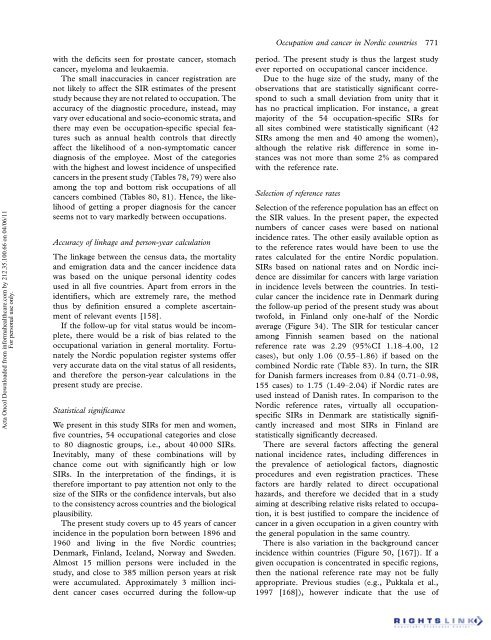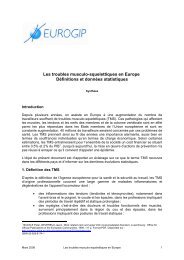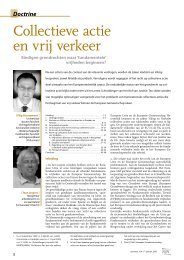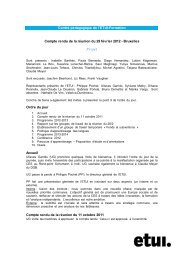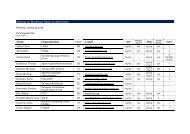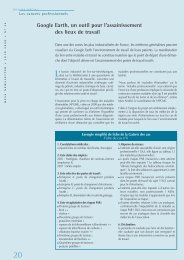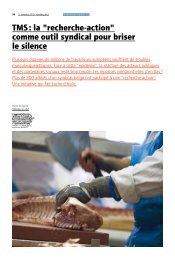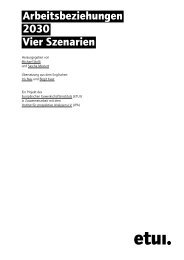Occupation and cancer - European Trade Union Institute (ETUI)
Occupation and cancer - European Trade Union Institute (ETUI)
Occupation and cancer - European Trade Union Institute (ETUI)
You also want an ePaper? Increase the reach of your titles
YUMPU automatically turns print PDFs into web optimized ePapers that Google loves.
Acta Oncol Downloaded from informahealthcare.com by 212.35.100.66 on 04/06/11<br />
For personal use only.<br />
with the deficits seen for prostate <strong>cancer</strong>, stomach<br />
<strong>cancer</strong>, myeloma <strong>and</strong> leukaemia.<br />
The small inaccuracies in <strong>cancer</strong> registration are<br />
not likely to affect the SIR estimates of the present<br />
study because they are not related to occupation. The<br />
accuracy of the diagnostic procedure, instead, may<br />
vary over educational <strong>and</strong> socio-economic strata, <strong>and</strong><br />
there may even be occupation-specific special features<br />
such as annual health controls that directly<br />
affect the likelihood of a non-symptomatic <strong>cancer</strong><br />
diagnosis of the employee. Most of the categories<br />
with the highest <strong>and</strong> lowest incidence of unspecified<br />
<strong>cancer</strong>s in the present study (Tables 78, 79) were also<br />
among the top <strong>and</strong> bottom risk occupations of all<br />
<strong>cancer</strong>s combined (Tables 80, 81). Hence, the likelihood<br />
of getting a proper diagnosis for the <strong>cancer</strong><br />
seems not to vary markedly between occupations.<br />
Accuracy of linkage <strong>and</strong> person-year calculation<br />
The linkage between the census data, the mortality<br />
<strong>and</strong> emigration data <strong>and</strong> the <strong>cancer</strong> incidence data<br />
was based on the unique personal identity codes<br />
used in all five countries. Apart from errors in the<br />
identifiers, which are extremely rare, the method<br />
thus by definition ensured a complete ascertainment<br />
of relevant events [158].<br />
If the follow-up for vital status would be incomplete,<br />
there would be a risk of bias related to the<br />
occupational variation in general mortality. Fortunately<br />
the Nordic population register systems offer<br />
very accurate data on the vital status of all residents,<br />
<strong>and</strong> therefore the person-year calculations in the<br />
present study are precise.<br />
Statistical significance<br />
We present in this study SIRs for men <strong>and</strong> women,<br />
five countries, 54 occupational categories <strong>and</strong> close<br />
to 80 diagnostic groups, i.e., about 40 000 SIRs.<br />
Inevitably, many of these combinations will by<br />
chance come out with significantly high or low<br />
SIRs. In the interpretation of the findings, it is<br />
therefore important to pay attention not only to the<br />
size of the SIRs or the confidence intervals, but also<br />
to the consistency across countries <strong>and</strong> the biological<br />
plausibility.<br />
The present study covers up to 45 years of <strong>cancer</strong><br />
incidence in the population born between 1896 <strong>and</strong><br />
1960 <strong>and</strong> living in the five Nordic countries;<br />
Denmark, Finl<strong>and</strong>, Icel<strong>and</strong>, Norway <strong>and</strong> Sweden.<br />
Almost 15 million persons were included in the<br />
study, <strong>and</strong> close to 385 million person years at risk<br />
were accumulated. Approximately 3 million incident<br />
<strong>cancer</strong> cases occurred during the follow-up<br />
<strong>Occupation</strong> <strong>and</strong> <strong>cancer</strong> in Nordic countries 771<br />
period. The present study is thus the largest study<br />
ever reported on occupational <strong>cancer</strong> incidence.<br />
Due to the huge size of the study, many of the<br />
observations that are statistically significant correspond<br />
to such a small deviation from unity that it<br />
has no practical implication. For instance, a great<br />
majority of the 54 occupation-specific SIRs for<br />
all sites combined were statistically significant (42<br />
SIRs among the men <strong>and</strong> 40 among the women),<br />
although the relative risk difference in some instances<br />
was not more than some 2% as compared<br />
with the reference rate.<br />
Selection of reference rates<br />
Selection of the reference population has an effect on<br />
the SIR values. In the present paper, the expected<br />
numbers of <strong>cancer</strong> cases were based on national<br />
incidence rates. The other easily available option as<br />
to the reference rates would have been to use the<br />
rates calculated for the entire Nordic population.<br />
SIRs based on national rates <strong>and</strong> on Nordic incidence<br />
are dissimilar for <strong>cancer</strong>s with large variation<br />
in incidence levels between the countries. In testicular<br />
<strong>cancer</strong> the incidence rate in Denmark during<br />
the follow-up period of the present study was about<br />
twofold, in Finl<strong>and</strong> only one-half of the Nordic<br />
average (Figure 34). The SIR for testicular <strong>cancer</strong><br />
among Finnish seamen based on the national<br />
reference rate was 2.29 (95%CI 1.18 4.00, 12<br />
cases), but only 1.06 (0.55 1.86) if based on the<br />
combined Nordic rate (Table 83). In turn, the SIR<br />
for Danish farmers increases from 0.84 (0.71 0.98,<br />
155 cases) to 1.75 (1.49 2.04) if Nordic rates are<br />
used instead of Danish rates. In comparison to the<br />
Nordic reference rates, virtually all occupationspecific<br />
SIRs in Denmark are statistically significantly<br />
increased <strong>and</strong> most SIRs in Finl<strong>and</strong> are<br />
statistically significantly decreased.<br />
There are several factors affecting the general<br />
national incidence rates, including differences in<br />
the prevalence of aetiological factors, diagnostic<br />
procedures <strong>and</strong> even registration practices. These<br />
factors are hardly related to direct occupational<br />
hazards, <strong>and</strong> therefore we decided that in a study<br />
aiming at describing relative risks related to occupation,<br />
it is best justified to compare the incidence of<br />
<strong>cancer</strong> in a given occupation in a given country with<br />
the general population in the same country.<br />
There is also variation in the background <strong>cancer</strong><br />
incidence within countries (Figure 50, [167]). If a<br />
given occupation is concentrated in specific regions,<br />
then the national reference rate may not be fully<br />
appropriate. Previous studies (e.g., Pukkala et al.,<br />
1997 [168]), however indicate that the use of


